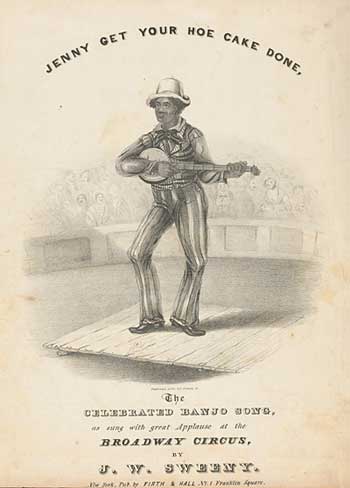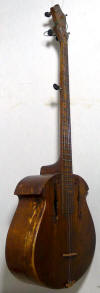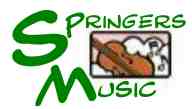|
 In 1846 William Temlett
established a factory in London making 6 & 7 string banjos and is
thought to be amongst the first regular makers in the UK. These were
regular style banjos.
In 1846 William Temlett
established a factory in London making 6 & 7 string banjos and is
thought to be amongst the first regular makers in the UK. These were
regular style banjos. |
Little is documented about
banjos prior to 1840s. It is generally accepted that the instrument
was developed from African Americans based on gourd bodied banjos
sometimes known as strum strums. Membrane (skin resonators)
instruments are known earlier in Asia, from Persia to Japan. Banjos
made before the 1840s were either made by their players or
commissioned one off instruments. The first recorded banjo maker was
William Boucher of Baltimore. It is known that a certain Joe
Sweeny, a banjo playing musical hall performer came from the USA to
England in early 1840s and gained much popularity with his blackened
up ,performances. It is said that his influence started the banjo
craze. Apparently he would not let anyone inspect his Boucher and
quickly put it away after each performance. The result was would be
banjo players made drawings or described what they wanted to
instrument makers with various interpretations. A guitar made a six
string “banjo” with a wooden table (left), another an elaborate “Casino”
banjo but with standard 5 strings and a Boucher style head, but
still no velum, often not with a round pot various interpretations
were produced.
There were banjos made it
seems before Sweeny’s appearance in England. There may well have
been separate developments of banjos before him. English made
banjos are predominantly 6 and 7 string in the mid 19th
century. A 9 string banjo ( 3 octave strings) and 13 string English
banjo exist (ex Ruben Greene collection) which could be an
interpretation of a
harp guitar. ( eg Light c1815)
In 1846 William Temlett
established a factory in London making 6 & 7 string banjos and is
thought to be amongst the first in the UK.
|
|
 |
|
 |
5 string "Cassino" banjo, (left)so called because
of its decoration. circa 1840
Wooden top
banjo circa 1840s, later "modernised" with frets and
tuners.(right) |
 |
A Pollman 5 string banjo mandolin of the 1880s. A
short lived revival of wooden top banjos. Vega also produced one
with a standard banjo pot in the 1920s-30s. |
 |

